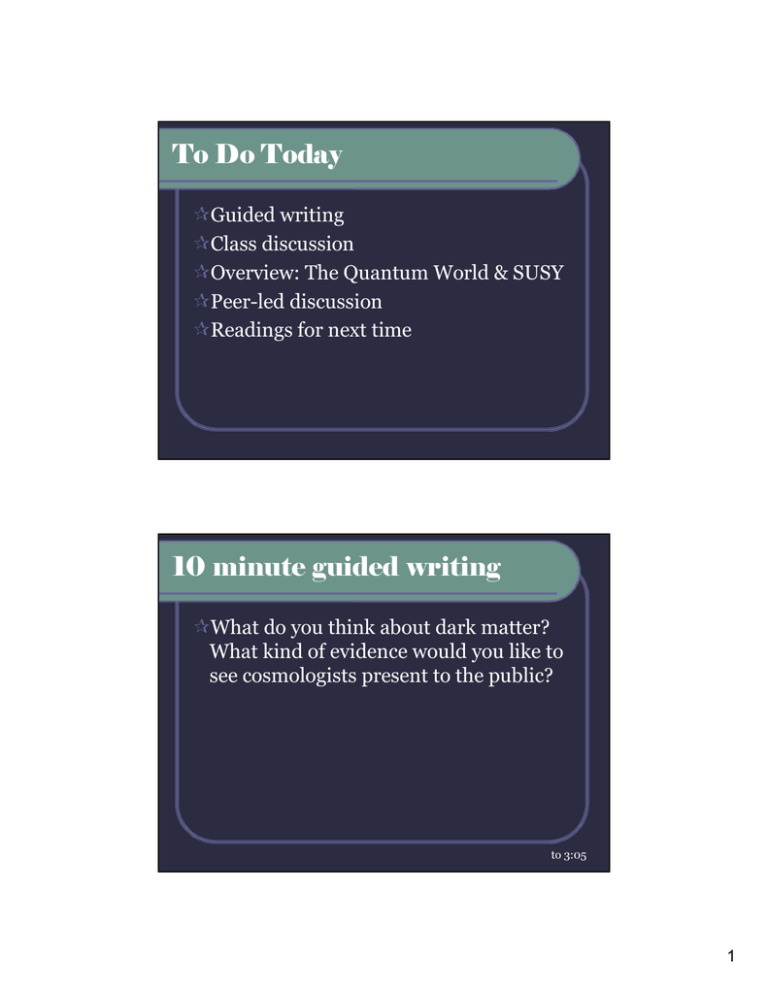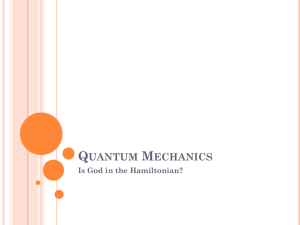To Do Today
advertisement

To Do Today Guided writing Class discussion Overview: The Quantum World & SUSY Peer-led discussion Readings for next time 10 minute guided writing What do you think about dark matter? What kind of evidence would you like to see cosmologists present to the public? to 3:05 1 Let’s make a list . . . What questions would you like to see answered about dark matter if you were visiting a planetarium? Think about: parents, children, teachers, typical adults . . . to 3:10 Class discussion Is it more "radical" to 'invent' a new form of invisible matter, or is it more radical to replace Newton's and Einstein's theory of gravity? If you think “dark matter” is more radical, come sit in the back two rows on the right side of the room (near the door). If you think “changing gravity” is more radical, come sit in the front two rows on the right side of the room. One volunteer from each group 2 Let’s make two lists . . . Dark matter PRO and CON (including questions you/we don’t know the answer to) Modified gravity PRO and CON Discuss in your groups and then we’ll share on the board to 3:20 Overview: The Quantum World What is a “quantum”? to 3:40 3 MACHOS to 3:40 MACHOS There cannot be enough stars, planets, comets, asteroids, etc. to make up the dark matter. We’re focusing the hunt for dark matter on the quantum world! to 3:40 4 WIMPs: Weakly Interacting Massive Particles Overview: The Quantum World These particles belong to the quantum world, so they have strange properties. Quantum “stuff” is both a wave AND a particle. The Bohr atom vs. the electron cloud model to 3:40 5 Overview: The Quantum World QM isn’t “deterministic” – instead it deals with probabilities. For example, a particle has a “wavefunction” that describes the probability of it being in each possible location. In a sense, the particle is in all of those locations. The Bohr atom vs. the electron cloud model to 3:40 Interpretations of Quantum Mechanics The Copenhagen Interpretation (Bohr and Heisenberg): the measurement process “collapses the wavefunction” or “picks one state.” to 3:40 6 What is Schrodinger's Cat Paradox? (in his own words) "One can even set up quite ridiculous cases. A cat is penned up in a steel chamber, along with the following diabolical device (which must be secured against direct interference by the cat): in a Geiger counter there is a tiny bit of radioactive substance, so small that perhaps in the course of one hour one of the atoms decays, but also, with equal probability, perhaps none; if it happens, the counter tube discharges and through a relay releases a hammer which shatters a small flask of hydrocyanic acid." -- Erwin Schrodinger Translation by John D. Trimmer Interpretations of Quantum Mechanics The Copenhagen Interpretation (Bohr and Heisenberg): the measurement process “collapses the wavefunction” or “picks one state.” The Many Worlds Interpretation: for every outcome with a nonzero probability, there is some world where that outcome occurred. All the “worlds” exist at the same time, as though they are in layers. Objective Collapse: wavefunctions will be collapsed by something objective, i.e. some physical threshold is reached. No tests can tell the difference between these scenarios! So they are philosophical questions (“metaphysics”), not scientific theories. to 3:40 7 QM and Philosophy Einstein: “God does not play dice with the Universe.” Bohr: “Stop telling God what to do!” The role of the “observer” as actually telling the Universe what to do is unsettling for many. to 3:40 QM and the “Standard Model” When QM was developed, we only knew about: Protons Neutrons Electrons Photons Discoveries of new particles: 1937, 1947, 1948, 1951, 1952 . . . We began to realize that these were not fundamental particles. They were made of smaller building blocks, called quarks. By the 1970s, we’d combined this information into the Standard Model of particle physics to 3:40 8 Fundamental Particles The Fermions are matter. Leptons and quarks cannot be broken down, but they can be converted to pure energy, and the heavy ones can decay to the light ones. Bosons are responsible for “communicating the forces of nature between Fermions.” to 3:40 Fundamental Particles Each Fermion has an “antiparticle” with the same properties but the opposite charge. If antiparticle pairs run into each other, they annihilate, releasing their energy to the Universe. This means that there must have been fewer anti-quarks and anti-leptons in the early Universe than quarks and leptons. Otherwise the Universe would be empty! to 3:40 9 to 3:40 Interactions and Conservation Particles interact when they: Bump into each other, exchanging kinetic energy Gravitate towards one another Exchange photons (interact electromagnetically) Collide to produce new products to 3:40 10 u Interactions and Conservation +⅔ After an interaction, the Universe will have the same: Mass, energy, and electric charge “Colour” charge (quarks can have red, green, or blue colour charge, and the results must always have one of each. Example is a proton!) u +⅔ d -⅓ to 3:40 u Interactions and Conservation +⅔ After an interaction, the Universe will have the same: Mass, energy, and electric charge “Colour” charge (quarks can have red, green, or blue colour charge, and the results must always have one of each. Example is a proton!) The Universe ends up having a nice symmetry u +⅔ d -⅓ Every particle has an antiparticle with the same mass and an opposite charge This “principle of opposites” is important later! The totals always balance out! to 3:40 11 Fundamental Particles The photon “mediates” the electromagnetic force. The gluon is responsible for the strong force (it “glues” the Universe together) The W,Z bosons are responsible for the weak force What about gravity? We don’t know! If the Higgs exists, then particles that interact with the Higgs boson are permitted to have mass through that interaction. to 3:40 How does this relate to dark matter? There are three “flavors” of neutrinos, very low-mass particles that interact with matter very rarely. If each of them had 1/100,000th the mass of the electron, that could make a LOT of dark matter! If you want to find them, you need either a lot of neutrinos (i.e. a nuclear reactor) or a really big detector (i.e. SuperKamiokande or the Solar Neutrino Observatory) to 3:40 12 Super-K Neutrinos are WIMPs Weakly Interacting Massive Particles There are lots of other possibilities, and they don’t have to have anything in common. But neutrinos set us down the path of looking to “weird” stuff in the Standard Model. “If looking for MACHOs is like looking for a needle in a haystack, then looking for WIMPs is like looking for an invisible needle in a haystack no one has found yet.” to 3:40 13 Why can’t neutrinos be dark matter? They’re too hot! They move at velocities close to the speed of light. This “heat” keeps galaxies from forming. It takes much too long for gravity to “overcome” the heat of neutrinos and form large-scale structure. to 3:40 Supersymmetry Supersymmetry is an unproven theory that postulates a boson for every fermion and a fermion for every boson! It solves some problems deep in the mathematics of the Standard Model. In this theory, bosons and fermions are intimately related, or in other words, matter and force are one concept, just like space and time. to 3:40 14 Supersymmetric Pairs Supersymmetry is also called SUSY Electron/Selectron, Muon/Smuon, Tau/Stau, Neutrino/Sneutrino, Quark/Squark Photon/Photino, Gluon/Gluino, Z Boson/Zino, W Boson/Wino, Higgs Boson/Higgsino to 3:40 Supersymmetric Pairs They’ve never been observed! They must be much more massive than the non-super partners, and can’t be created in accelerators/colliders. to 3:40 15 Supersymmetry and dark matter Supersymmetric particles are prime candidates to be the dark matter of galactic halos. But there is as yet no evidence for supersymmetric particles, although we are looking very hard! to 3:40 Supersymmetry and dark matter Supersymmetric particles are prime candidates to be the dark matter of galactic halos. The most likely supersymmetry theories keep protons from decaying quickly, and also have a stable lightest supersymmetric particle. These theories have Rparity, where “even” or “oddness” is preserved. This means the lightest particle has nothing to decay to! These ‘neutralinos’ are good candidates. to 3:40 16 Hints of the anthropic principle “Reverse Experiments” Particle & antiparticle numbers can’t cancel out exactly, or we wouldn’t be here. There can’t be too many hot neutrinos in the early Universe, or we wouldn’t be here. Protons can’t decay too quickly, or we wouldn’t be here. These are the best tools astronomers have for answering cosmological questions (“Can this model Universe produce the Universe we know to exist?”) . . . But they are also what is known as anthropic arguments. to 3:40 Hints of the anthropic principle “Reverse Experiments” Particles & antiparticles can’t cancel out exactly, or we wouldn’t be here. There can’t be too many hot neutrinos in the early Universe, or we wouldn’t be here. Protons can’t decay too quickly, or we wouldn’t be here. The anthropic principle is the idea that we must live in a Universe capable of forming galaxies, stars, planets, and life, or else we wouldn’t be here to observe it. All physical laws and principles must be consistent with a Universe that produces humans! to 3:40 17 Peer-guided discussion Work in groups. 1. Group 1: Colleen, Nicki, Dipesh, Yan 2. Group 2: Ryan, Jonathon, Faheem, Sam 3. Group 3: Dan, Meghan, Rashik, Eli 4. Group 4: John, Justin, DJ, Ethan Until 3:45 Peer-guided discussion 1. 2. 3. 4. Group 1: Colleen, Nicki, Dipesh, Yan Group 2: Ryan, Jonathon, Faheem, Sam Group 3: Dan, Meghan, Rashik, Eli Group 4: John, Justin, DJ, Ethan Question: Quantum theory & SUSY are strange. In what ways do they relate to some of the themes we thought about and discussed in relation to Einstein's Dreams? Be prepared to share your thoughts, ideas, and opinions. Think about free will, determinism, freedom, social consequences. You can use some of the ideas we worked on last week; if it helps, you can take the ideas to bizarre extremes, like Lightman did, and think about how that would affect the world. For five minutes, each group should work on coming up with a good discussion question centering around this topic. Then we’ll share, and then have small-group discussions on each question. Until 3:45 18 Peer-guided discussion 1. 2. 3. 4. 5. Group 1: Colleen, Nicki, Dipesh, Yan. Question: Group 2: Ryan, Jonathon, Faheem, Sam. Question: Group 3: Dan, Meghan, Rashik, Eli. Question: Group 4: John, Justin, DJ, Ethan. Question: Discuss these in a new set of small groups: [Colleen, Ryan, Dan, John], [Nicki, Jonathon, Meghan, Justin], [Dipesh, Faheem, Rashik, Ethan], and [Yan, Sam, Eli, DJ]. Until 4:05 Readings for next time Hooper, Chapters 6 & 7 Ferreira, Chapter 11 19 Back to the Higgs boson When particles interact with the Higgs boson, it gives them mass. Particles that easily interact have a lot of mass; particles that don’t interact at all (like the photon!) remain massless. But particles contribute mass to the Higgs boson too, so SUSY must keep the boson from obtaining a tremendous mass. It can do this because a particle and its superpartner will add/take away mass, and the Higgs is OK. to 3:40 20





